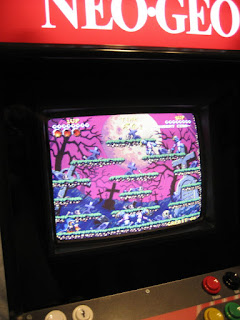A dream of mine has always been to own an arcade cabinet. Ever since the days of playing games in arcades, bowling alleys, and diners as a boy, I've wondered what it would be like to be able to play an arcade game for free whenever I wanted. This summer, as I was wrapping up my touchscreen jukebox project, I was considering what my next project should be. In September, just for grins, I priced out a cabinet with the options I wanted. While it seemed economically out of reach at first, I decided that I could make a few financial sacrifices to make it work. And there it began.
I decided to build a Neo Geo Bartop for several reasons. (For those unfamiliar with Neo Geo, see here for background info.) Mainly, it was because I love the games. I first read about Neo Geo and its prohibitively expensive home console and games in an early issue of Electronic Gaming Monthly circa 1990. I never played Neo Geo console or arcade games as a kid, but rather got into them in my 20's when I learned how to mod the Xbox and play emulated games on it. I had noticed the amazing graphics, sound, and overall fun of many of the Neo Geo games. When deciding what arcade game to build, I looked for "the most bang for the buck." The system should be PC-based, since I already had an old PC laying around. This is a much more versatile solution than using an actual arcade board, which would yield only one game, or a handful at most. The fact that there are 150 Neo Geo games, many of which are great, all with the same controls sealed the deal. Simple and attractive artwork, with a ROM set that is easy to emulate on an old PC helped, too. I chose to build the cabinet from a pre-fab kit since I lack most of the tools and skills required to cut my own. I chose a bartop (a.k.a. tabletop) kit as opposed to a full-size cabinet so that it wouldn't take up as much room in my rapidly shrinking apartment. I decided to build a 1-player cabinet, but there's a USB port on the front panel so that an optional 2nd controller can be added for 2-player games. I could envision a finished product made of 100% authentic arcade parts, most importantly a CRT (tube) arcade monitor, that would net a hyper-realistic arcade experience for a fraction of the cost and space requirements of a full-size system. It took over 2 months to build, and now it's done.
After having played with it for a few days, I can honestly say I love it. The games look and feel great. The controls are spot on. I'd go so far as I like it better than an actual Neo Geo cabinet, but I'm biased. This was not only the most difficult and expensive, but also the funnest project I've ever worked on by far. Planning it and building it was just as fun as playing it. It was well worth all the (minor) injuries I sustained during construction. The biggest obstacles to completion were sufficently cooling the PC and getting the bezel (black area around the screen) painted and mounted. Cooling the PC required 5 cooling fans: 2 in's and 3 out's. Quite a pain to set up, but seems to be running OK. The bezel, consisting of plexiglass and a plastic frame, had to be spray painted and velcro-ed, respectively. Very difficult to set up because it has to be just right since that's what people who play the thing are looking at 95% of the time.
As this is my first arcade cabinet build, I'd like to thank the following people, in no particular order, without whom this project would have never been completed: My friends Joe and John at BCG, Andy at Ultimarc, Dom, Elton, and Bill at my work, Gerry at NorthCoast Custom Arcades, Todd at ArcadeOverlays, Suzo Happ, and the forum mods and contributors at Racketboy, BYOAC, Neo-Geo.com, and KLOV.
Parts list:
Part Cabinet Kit (Ultimate Bartop I) Monitor (Wells Gardner D7700 13") VGA Breakout Cable T-molding ArcadeVGA (AGP) Video Card Logitech Desktop Speakers White Cold Cathode Light Competition Joystick Ultimate Pushbuttons Smart Strip Surge Protector I-Pac2 Wire + Cable Ties Custom Sideart, Marquee, and CPO Control Panel Plexiglass Marquee Mirror Misc. Screws PC (Mobo, CPU, PSU, HDD, RAM) Black Spray Paint Matte Board Case Fans Velcro USB Extender | Vendor NorthCoast Custom Arcades Suzo Happ Ultimarc NorthCoast Custom Arcades Ultimarc Newegg Newegg Suzo Happ Suzo Happ Amazon Ultimarc Radio Shack ArcadeOverlays BCG BCG Lowes (already had) Lowes AC Moore Best Buy/Newegg Lowes (already had) |
PC Parts list:
Part Motherboard CPU Hard Drive RAM Power Supply OS Frontend MAME | Model AsRock K7S41GX AMD Sempron 2500+ (1.66GHz) Seagate 250GB (IDE) 1GB (2 x 512MB) DDR 400 Generic 300W Windows XP Professional SP3 Maximus Arcade 2.10 0.139 |






































